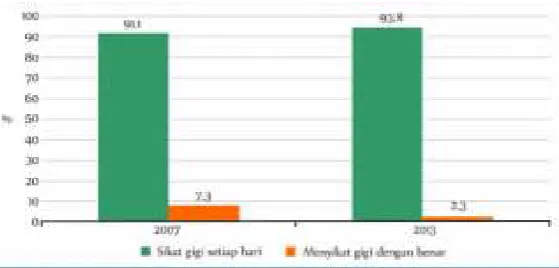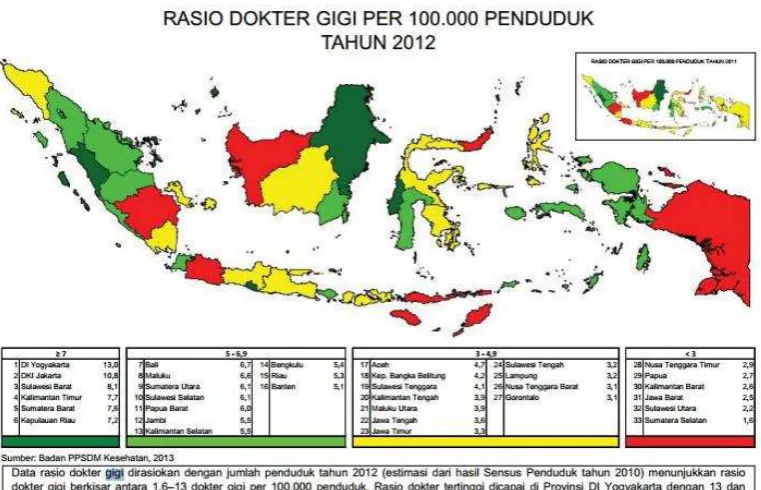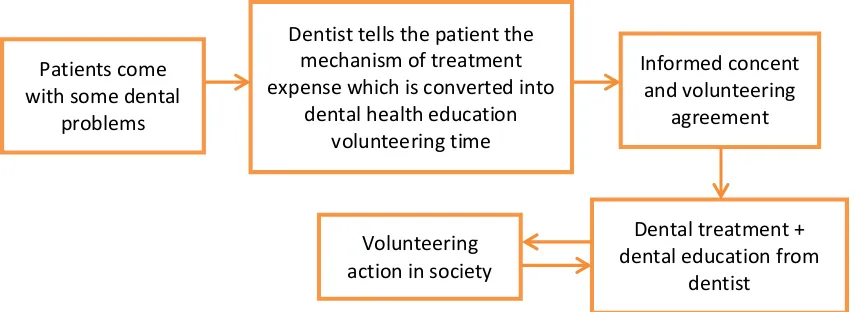DENTAL HEALTH SERVICE IN INDONESIAN RURAL AREA
USING DENTAL HEALTH EDUCATION VOLUNTEER
PAYMENT CONCEPT
Kurnia Istiqomah
Universitas Gadjah Mada, Faculty of Dentistry
Jalan Denta No. 1 Sekip Utara, Bulaksumur, Daerah Istimewa Yogyakarta kurniaistikom@gmail.com
Abstract
Public awareness to visit a dentist in Indonesia is still quite low, especially in the rural area. One of the reason is the assumption of costly dental care. The other reason is the distribution of dentists that have not been evenly distributed in Indonesia. The economic and the dentist distribution factors highly influence the frequency of people with low-income and in rural
areas to have dental care. The infrequent visit leads to people’s inadequate health knowledge.
Therefore, the prevalence of dental problems in Indonesia is still high. To overcome this issue, it is necessary to develop a concept of providing a dental treatment without having people paying the cash. Therefore, an alternative concept was being made based on the Indonesian condition and a successful method that has been implemented in other country rural areas. The aim of this study was to investigate Indonesian dental condition and make an alternative dental health service and payment concept that can be implemented in rural areas.This study was a literature review and the data was obtained from many sources.Based on the literature, the concept of payment of dental health service may be effective to be implemented in Indonesian rural areas.
Keywords: dental health, dental health education volunteer, rural area, community development.
DENTAL PROBLEMS IN INDONESIA
The proportion of dental problems in Indonesia is still high which was indicated by a record of 15.3% to 36.2% prevalence within the community [1]. Despite the high prevalence, the Effective Medical Demands or the ability and affordability to get services from the dental medical personnel were merely 5.1% to 10.3% [1]. It means that the proportion of dental problem was high, but the ability and affordability to get dental service was still low.
Fig. 1 Dental and oral problem proportion based on province in Indonesia (2007 and 2013)
Fig. 2 EMD based on province in Indonesia (2007 and 2013)
The assumption of expensive fee to have dental health care and treatment was a reason
Fig. 3 Dental and oral problem proportion based on household expenditure in Indonesia (2007 and 2013).
Fig. 4 EMD based on household expenditure in Indonesia (2007 and 2013).
Data from Riskesdas 2013 reported the percentage of people aged older than 10 years old who brush their teeth regularly was 93.8%. However, only 2.3% of them had the knowledge on proper technique for brushing teeth after having meal and before bedtime [2]. It indicated that most people recognize the importance of brushing their teeth, but only a few how to brush the teeth correctly. It is allegedly caused by the lack of dental care knowledge as
well as professionals’ assistance within the community. However, there are several probabilities of the dental problem occurrences.
RATIO AND DISTRIBUTION OF DENTIST IN INDONESIA
Ideally, the ratio between dentist and population in Indonesia is 11:100,000[3]. It means there are eleven dentists who serve 100.000 people. In fact, the ratio between dentists and population in Indonesia reached 4.5:100,000 in 2013[4]. In addition, the dentist is also
unevenly distributed throughout Indonesia. The highest ratio of dentists-population was in DI Yogyakarta which reached 13:100.000[4]. Meanwhile in other regions of Indonesia, the ratio is still low, precisely in South Sumatera with a ratio of 1.6:100.000[4] which is far from the target of 11:100.000 people. Uneven number of dentists in Indonesia leads to insufficient health service for oral and dental problems, particularly in certain areas in Indonesia. Obstacle dealing with accommodation to reach health care center is accompanied by the scarcity of dental health workers in rural areas which worsen the status of public knowledge and awareness for dental health.
Fig.6 Indonesian ratio between dentist and population in 2012
DENTAL TREATMENT WITH DENTAL HEALTH EDUCATION VOLUNTEERING CONCEPT: SOLUTION CONCEPT FOR RURAL AREA DENTAL SERVICE
Fig. 7 Conceptual framework of dental services.
The implementation of the concept is initiated by the arrival of the dentist into the rural areas and the introduction to the local community as well as to socialize the concept. Basically, the concept is to provide the dental treatments without paying it with money as the patients can register themselves to be dental health education volunteers. The volunteering time is based on their dental expenses. Subsequently, the patients should sign the informed concent and the volunteering agreement. They who have listed in the activity will have a training from the dentist regarding with dental health and they will also have a treatment for their dental problems. There will be a schedule to regulate the volunteers to carry out dental health education activity in the society with the supervision of the dentist. In general, there are several adventages obtained by the volunteers. They will have their dental problems treated and their knowledge about dental health increased. This concept also allows dentists to perform curative and preventive treatments. Education from the dentist will improve community knowledge and awareness on dental health and care. In addition, it supports people to contribute actively in improving community health, particularly dental health. Therefore in the future, they will be able to take care of their dental health independently as well as to disseminate the knowledge. Hopefully, the improvement of knowledge and treatment in dental health with this concept will reduce the prevalence of dental problems in Indonesia.
CONCLUSION
Innovation related with in dental health education and treatment should be a consideration in association with the prevalence of dental problems in Indonesia. The concept of converting dental expenses into dental health education voluntary time as an alternative to provide the services among the low income people in the rural areas seems to be appropriately implemented in Indonesia. In addition to improve community’s knowledge on dental health, the concept of actively involving the dentist and the community is a method to encourage the community keeping their dental health and care independently.
REFERENCES
[1] Pusat Data dan Informasi Kementrerian Kesehatan RI (2014) Situasi kesehatan gigi dan mulut, Jakarta: Kementerian Kesehatan RI. Available at:
[2] Badan Penelitian dan Pengembangan Kesehatan Kementrerian Kesehatan RI (2013) Riset kesehatan dasar 2013, Jakarta: Kementerian Kesehatan RI. Available at:
http://www.pusdatin.kemkes.go.id/resources/download/general/Hasil%20Riskesdas%20 2013.pdf. accessed in March 2016.
[3] Kementrerian Kesehatan RI (2012) Rencana program pelayanan kesehatan gigi dan mulut, Jakarta: Kementerian Kesehatan RI. Available at:
http://dinkes.babelprov.go.id/sites/default/files/data/Renc.Program.pdf. accessed in March 2016.
[4] Pusat Data dan Informasi Kementerian Kesehatan RI (2013) Peta kesehatan Indonesia tahun 2012, Jakarta: Kementerian Kesehatan RI. Available at:
http://www.pusdatin.kemkes.go.id/resources/download/pusdatin/peta -kesehatan/peta-kesehatan-2012.pdf. accessed in March 2016.



